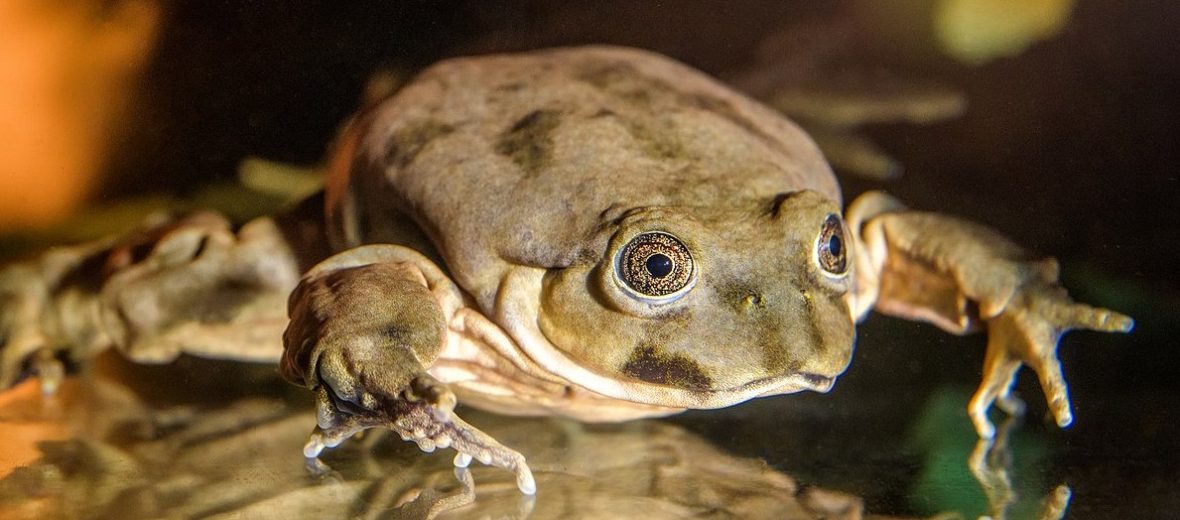
The Lake Titicaca frog, aka Titicaca water frog, hails from the Lake Titicaca basin, which includes the rivers that flow into it as well as the smaller connected lakes like Lagunillas, Arapa, and Saracocha, in the Andean highlands of Peru and Bolivia. These frogs are totally aquatic, never leaving the water; not even to breed. Due to a number of threats including: habitat loss at the hands of marine & freshwater aquaculture and dams; fishing; harvesting aquatic resources; pollution from agriculture; invasive species (and with them disease and predation); and climate change, these amazing frogs are listed as Endangered by the IUCN. Their numbers are also decreasing. This IUCN status was last updated in 2019.
First the Stats…
Scientific name: Telmatobius culeus
Weight: Up to 2 lbs.
Length: Up to 20 inches
Lifespan: Up to 20 years
Now on to the Facts!
1.) They are closely related to the semiaquatic marbled water frog. But the marbled water frog is smaller and lacks the excess skin.
2.) Only the Lake Junin frog, the helmeted water toad, and African Goliath frog can grow larger than the Lake Titicaca frog. But the African Goliath and helmeted water toad are land based.
3.) While they can get up to 20 inches long, and longer, they are typically only about 6.7 inches long, from snout to vent; and they weigh in at about .9 lb.
4.) Like other frogs, the females grow to be larger than males.
5.) Why the excess skin folds? They utilize the excess skin to aid in respiration in the cold water. Often times these frogs will perform “push-ups” or “bobs” up–and–down to allow more water to pass by its large skin folds, thus oxygenating themselves.
But wait, there’s more on the Lake Titicaca frog!
6.) If threatened, Titicaca water frogs can secrete a sticky whitish fluid from their skin in defense.
7.) These frogs can be found at depths of up to and possibly even over 33 feet.
Did you know…?
The fluid released from their skin is derived from alkaloids that are only found in their natural habitat. They are typically only terrible tasting, but not overly poisonous to attackers.
8.) Jacques Cousteau filmed individuals at around 400 feet deep. This is a record depth for any aquatic frog.
9.) The water temperature in which these frogs thrive is a chilly 46.5 – 63.5°F.
10.) They tend to be mostly nocturnal (active at night).
But wait, there’s still more on the Lake Titicaca frog!
11.) Breeding takes place year round.
12.) Amplexus (when the male grasps onto the female in lieu of mating) lasts up to 3 days.
Did you know…?
Titicaca water frogs will call underwater while near the shore. The basic and repeated call is only be detectable with a submerged microphone from a fairly short distance. The reason for the call has been debated and is thought to be to attract a female or as a territorial signal.
13.) Females lay upwards of 500 eggs each breeding session.
14.) The male will guard the eggs till they hatch into tadpoles; which is up to 2-weeks.
15.) They prey on amphipods, snails, and fish (up to 4 inches long). Cannibalism also exists, which is commonplace for many frogs.
But wait, there’s still a little more on the Lake Titicaca frog!
16.) Due to the nearly absent ears (tympanic membranes), it is presumed that they hear via vibration detection from their lungs; like numerous other frog species.
17.) The Titicaca water frogs are typically over-collected for human consumption. They also face the threats of pollution and introduced trout, and it may also be threatened by disease, like the deadly Chytrid fungus.
Did you know…?
Organizations, like zoos and museums, in Bolivia and Peru have undergone efforts to captive breed these frogs for later reintroduction into locales where they have vanished.
18.) These frogs are consumed as a traditional food or blended into a drink. They are also used in traditional medicine that is touted to be an aphrodisiac, to treat anemia, asthma, infertility, tuberculosis, osteoporosis, and fever. However, these claims are completely unsubstantiated and have led to the demise of these amazing creatures, for no valid purpose.
19.) Unfortunately, nutrient-rich pollution runoff from agriculture can cause algae blooms that cause oxygen levels to plummet, asphyxiating these frogs.
20.) In Peru, trade outside its native range at Lake Titicaca has been illegal for decades, and in 2014 it was awarded full protection by the country, making it illegal to catch this species of frog.
Now a Short Lake Titicaca Frog Video!
Be sure to share & comment below! Also, check out the Critter Science YouTube channel. Videos added regularly!
Want to suggest a critter for me to write about? Let me know here.
Photo credit: Petr Hamerník
Some source material acquired from: Wikipedia



